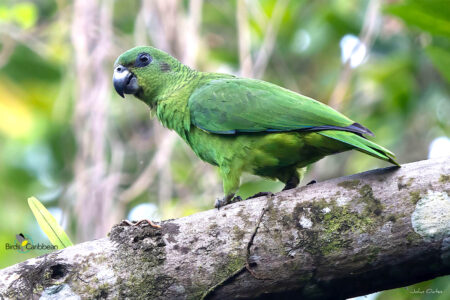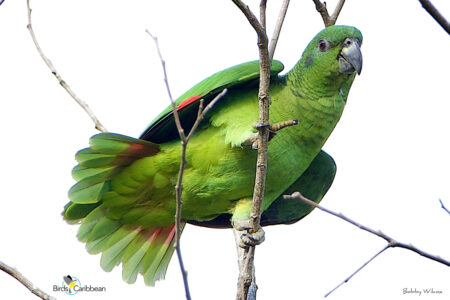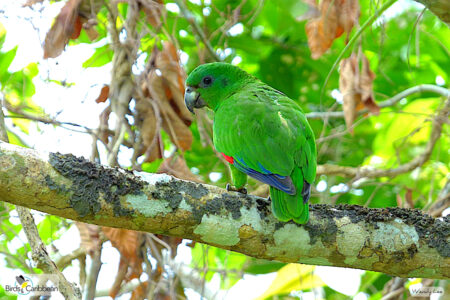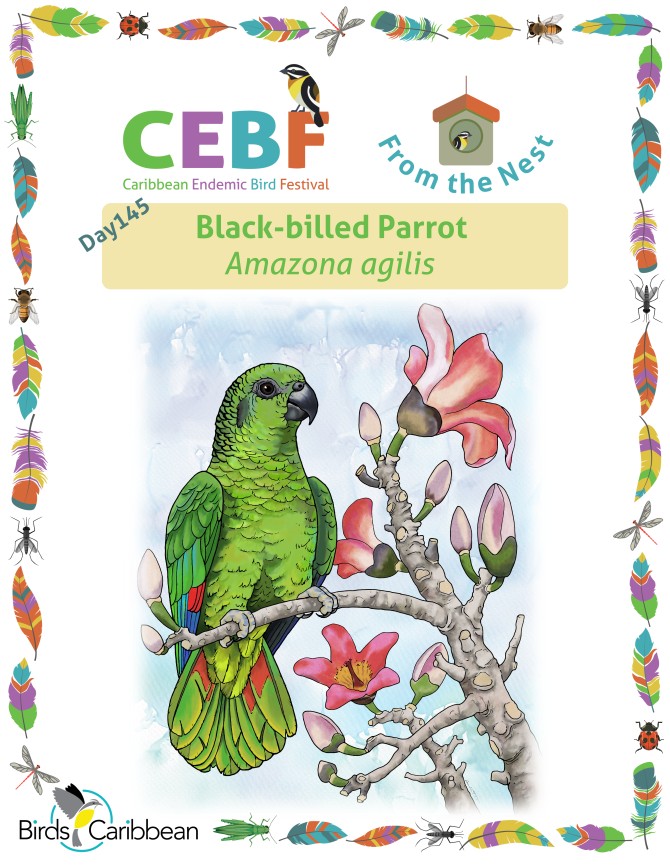Celebrate the Caribbean Endemic Bird Festival (CEBF) with us! Our theme in 2024 is “Protect Insects, Protect Birds”—highlighting the importance of protecting insects for birds and our environment. Have fun learning about a new endemic bird every day. We have colouring pages, puzzles, activities, and more. Download for free and enjoy learning about and celebrating nature!
Endemic Bird of the Day: Black-billed Parrot
Upon approaching Jamaica’s verdant Cockpit Country in the early morning, you will, depending on the time of year, see pairs or flocks of emerald green parrots flying purposefully across valleys, their flight ‘bugles’ echoing through the forested hills. Landing noisily in the treetops, they call to each other with a variety of squawks and warbles. These raucous birds are Black-billed or Yellow-billed Parrots—both of which are endemic to Jamaica! Their populations are restricted to the wet limestone forests of the Cockpit Country, the John Crow Mountains, and moist mountain forests of central Jamaica.
The Black-billed Parrots, simply called ‘Black Bill’ in Jamaica, are smaller and darker than the more colourful Yellow-billed Parrots. They are most closely related to another Caribbean endemic parrot, the Puerto Rican Parrot. Overall, Black-billed Parrots are a dark, forest green with flecks of scarlet above the grayish-black beak. Most Black-billed Parrots also sport a row of small, scarlet feathers in their wings, which show as a red flash in flight. The leading edges of the flight feathers progress from deep blue to turquoise, with the trailing edges grading from black to green. Splashes of red and yellow show in the tail feathers when the tail is spread.
Courtship for Black-billed Parrots begins as early as January when pairs can be seen flying apart from flocks. They are cavity nesters—they excavate a deep chamber in the trunk of a large tree which they use to nest, lay 3-4 eggs, and raise their young. Most nesting activity happens in March. Females incubate the eggs during which time their mates will bring food for them throughout the day. Eggs hatch after about 24 days and both parents feed and raise the hatchlings. Baby parrots are born completely featherless and with their eyes and ear openings fused shut. They’re also born with large feet which prevent them from toppling over when food is being regurgitated into their beaks. They grow baby feathers first which initially give them a decidedly spiky appearance! These eventually lay smooth as they continue to grow. Baby Black-billed Parrots play with small leaves and sticks—this activity strengthens the muscles which they will need to make long flights in search of food. After about 60 days, the young parrots are ready to leave the nest.
Black-billed Parrots forage over a wide area of forest, eating a variety of fruits, seeds, berries, blossoms, and even the leaves of trees. Like other parrots, they transport fruits and seeds using their beaks and feet, which they disperse over long distances—making them important but often overlooked seed dispersers of the forest.
The Black-billed Parrot is listed as Endangered. Threats to their survival include loss of forest habitat and the increasingly hot and dry climate. Hot, dry, and windy conditions are perfect for bushfires that destroy fruiting trees and kill baby parrots that are unable to fly. Predation by the endemic Jamaican Boa contributes to a high rate of nest failure (over 50%) in Black-billed Parrots. Poaching for the illegal pet trade has also increased, with parrots being sold along the roadside and through social media outlets—deleterious activities that rarely face enforcement action. Bauxite mining is an imminent threat to the blackbills’ stronghold in northeastern Cockpit Country. The survival of the Black-billed Parrot will depend on the protection of this important area, as well as enforcement of Jamaica’s Wildlife Protection Act.
Learn more about this species, including its range, photos, and calls here. Great news! If you’re in the Caribbean, thanks to BirdsCaribbean, you have free access to Birds of the World and you can find out even more in the full species account of this bird!
Thanks to Arnaldo Toledo for the illustration and Wendy Lee for the text!
Colour in the Black-billed Parrot
Download our West Indies Endemic Bird colouring page. Use the photos below as your guide, or you can look up pictures of the bird online or in a bird field guide if you have one. Share your coloured-in page with us by posting it online and tagging us @BirdsCaribbean #CEBFfromthenest
Listen to the calls of the Black-billed Parrot
The calls of the Black-billed Parrot include a harsh “mwah” as well as scratchy sounding “uh-luh” calls often given in flight.
Puzzle of the Day
Click on the image below to do the puzzle. You can make the puzzle as easy or as hard as you like – for example, 6, 8, or 12 pieces for young children, all the way up to 1,024 pieces for those that are up for a challenge!



Activity of the Day
FOR KIDS : Discover the birds of the Caribbean with Origami, the Japanese art of paper folding, and learn how to fold a Parrot out of paper with this video!
All you need is a square sheet of paper – 24 x 24 cm is ideal. The video will show you step by step how to fold and create your Parrot! Enjoy also our photos of the many parrots that are endemic to the Caribbean islands at the end of the video!
FOR KIDS AND ADULTS : Enjoy this video of a Black-billed Parrot in the wild!


